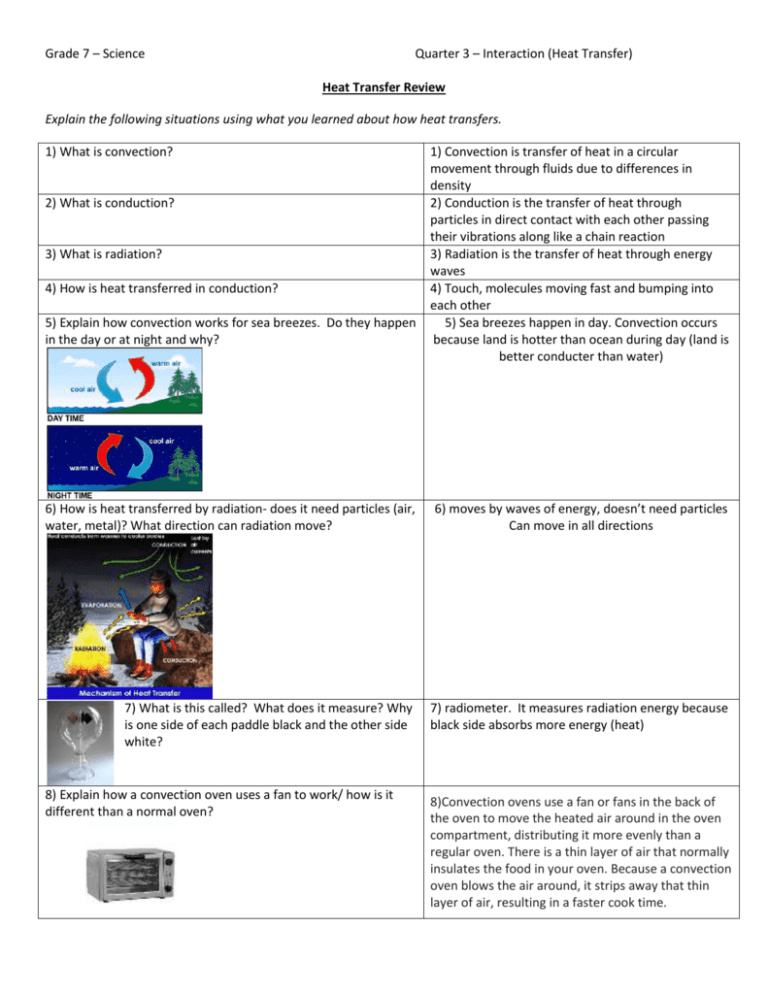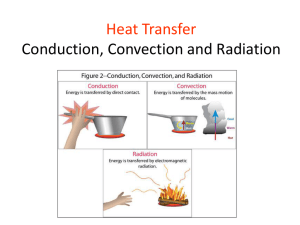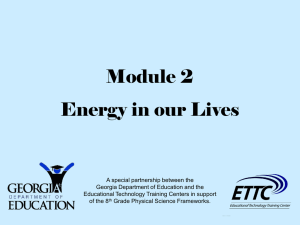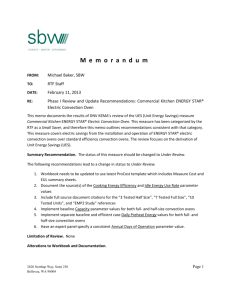Grade 7 – Science Quarter 3 – Interaction (Heat Transfer) Heat
advertisement

Grade 7 – Science Quarter 3 – Interaction (Heat Transfer) Heat Transfer Review Explain the following situations using what you learned about how heat transfers. 1) What is convection? 2) What is conduction? 3) What is radiation? 4) How is heat transferred in conduction? 5) Explain how convection works for sea breezes. Do they happen in the day or at night and why? 1) Convection is transfer of heat in a circular movement through fluids due to differences in density 2) Conduction is the transfer of heat through particles in direct contact with each other passing their vibrations along like a chain reaction 3) Radiation is the transfer of heat through energy waves 4) Touch, molecules moving fast and bumping into each other 5) Sea breezes happen in day. Convection occurs because land is hotter than ocean during day (land is better conducter than water) 6) How is heat transferred by radiation- does it need particles (air, water, metal)? What direction can radiation move? 6) moves by waves of energy, doesn’t need particles Can move in all directions 7) What is this called? What does it measure? Why is one side of each paddle black and the other side white? 7) radiometer. It measures radiation energy because black side absorbs more energy (heat) 8) Explain how a convection oven uses a fan to work/ how is it different than a normal oven? 8)Convection ovens use a fan or fans in the back of the oven to move the heated air around in the oven compartment, distributing it more evenly than a regular oven. There is a thin layer of air that normally insulates the food in your oven. Because a convection oven blows the air around, it strips away that thin layer of air, resulting in a faster cook time. Grade 7 – Science Quarter 3 – Interaction (Heat Transfer) 9) Why do cooks wear oven gloves when taking food out of the oven? 9) Gloves are poor conductors 10) Why is it difficult to estimate the temperature of things by simply touching them? 10) temperature from hand makes it difficult due to conduction/ temperature is relative so it depends on if your hand is hotter or coler than the object 11) If you hold one end of a metal nail against a piece of ice, the end in your hand soon becomes cold. Does the cold flow from the ice to your hand? Explain. 11) No, cold does not flow. Heat flows from your hand to the nail to the ice. Since your hand is losing heat, it feels cold. HEAT is the only thing that flows. 12) Many tongues have been injured by licking a piece of metal on a very cold day. Why would no harm result if a piece of wood were licked on the same day? 12) Metal is a good conductor of heat, the cold metal sucks heat so quickly from your tongue it can cause frost bite and damage the tissue of the tongue. 13) You can bring water in a paper cup to a boil by placing it over a hot flame. Why doesn’t the paper cup burn? hint: Paper burns at 451° Fahrenheit; water boils at 212° F. 13) Since the water is considerably cooler than the temperature needed to cause paper to burn, the paper remains unburnt while the water boils. When water boils, it strips away heat. The same is true of the evaporation of water (or sweat) on your skin. It cools. The paper cup won't burn until nearly all the water is gone, and it's ability to take away heat is exceeded by the flames ability to add heat. 14) The smoke will be initially hot. Since hot air is less dense than cool air it will rise. However, it will cool as it rises until its density is the same as the density of the air in the room. At that point, it will stop rising. 15) Radiation from the bulb travels quickly 14) In a still room, smoke from a cigar will sometimes rise only so far, not reaching the ceiling. Explain why. 15) If you turn an incandescent lamp on and off quickly while you are standing near it, you will feel its heat. But when you touch the bulb, it is not hot. Explain why you felt heat from it. 16) What would happen if the furnace was at the top of the house? Explain. 16) The bottom floors would be freezing because hot air rises so it would all be trapped at the top of the house Grade 7 – Science 17) To keep your coffee hot for as long as possible, should you add your cream first or wait until you are ready to drink it? Why? 18) On a very sunny day you wear a black coat and a transparent plastic coat. Which should be worn on the outside for maximum warmth? Explain. 19) Place cold water in a test tube. Hold the bottom end of the test tube and heat the top part in a flame until it boils. Why can you still hold on to the bottom of the test tube even when water on the top part is boiling? 20) If you wrap a piece of paper tightly around a thick metal bar and place it in a flame, the paper will not catch fire. Why? 21) Wrap a fur coat around a thermometer. Will the temperature rise? Quarter 3 – Interaction (Heat Transfer) 17) Add your cream first. The rate of heat loss depends on the difference in temperature. The greater the difference between room temperature and the liquid, the greater the heat loss. Although the cream is cool, its temperature is far closer to room temp than the hot coffee. So its rate of heat transfer is small compared to hot coffee cooling to room temp. It turns out that coffee with cream added actually cools about 20% more slowly than plain black coffee. 18) The black coat should be worn on the inside. The black absorbs radiant heat which would travel right through the transparent plastic coat. And then the plastic coat would prevent the heat from being removed by the air by way of convection. 19) Convection- hot fluid rises so it will never go to the botton of the testtube. 20) The metal will conduct the heat away from the paper 21) No, the thermometer will not heat up because it is the same temperature as the coat. There has to be a difference in temperature in order for heat transfer to take place 22) Explain how ‘firewalkers’ can walk safely across a bed of redhot coals in bare feet. 22) Because the rate of heat transfer is slow, because coals are not very good conductors. If they walk fast enough, there is only a small amount of heat transferred to their feet, and they do not burn. 23) Where is the best place to put the air conditioner and why? 24) put A/C close to ceiling or at top of house due to convection cold air sinks 25) Explain the two methods of heat transfer that makes a pot of water boil on a stove. 25) Conduction where touching the stove and through the sides of the pot and convection in the water itself Grade 7 – Science 26) If you have a cup of water at 80 degrees celsius and mix it with another cup of water at 20 degrees celsius, what temperature will they become and why? 27) Why does blowing over hot soup cool the soup? 28) How would placing a dented Ping-pong ball in boiling water remove the dent? 29) How does a blanket keep you warm? (hint: there are two ways) Does it provide you with heat? Quarter 3 – Interaction (Heat Transfer) 26) Take the average of 80 and 20 = 50 degrees because of conduction spreading from hot to cold 27) Convection cooling is a very effective method of heat transfer 28) Hot air expands and pushes the dent out 29) Keeps a layer of air above you and air is a bad conductor (aka is a good insulator) so your body heat stays close to you. Blanket also prevents convection from happening because warm air is trapped and can’t rise. No, the blanket does not provide you with heat










